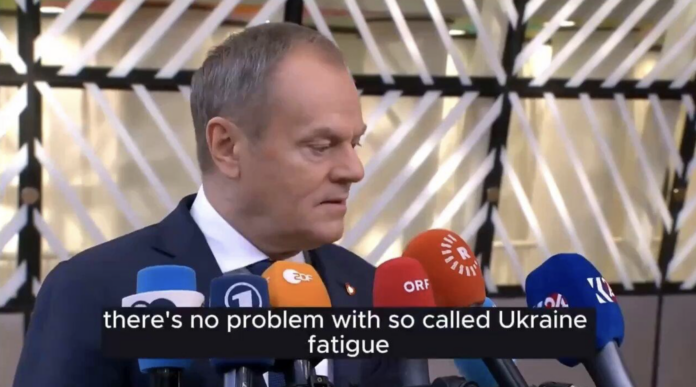
The Ukrainian crisis has entered its third year, with the conflict reaching a stalemate. Despite initial victories, the Ukrainian side’s performance faltered in the second year, failing to meet President Zelensky’s expectations for a turnaround.
Fatigue among U.S. and European leaders in addressing the Ukrainian crisis, which emerged in 2023, continues to spread. Additionally, since October 2023, a new round of the Palestinian-Israeli conflict has had a cascading effect in the West, contributing to a decline in public opinion regarding the Ukrainian crisis.
America’s Weariness of Ukraine’s Struggles
During Zelensky’s second visit to the U.S. in September 2023, he encountered a notably different atmosphere in Congress compared to his previous visit at the end of 2022. With the House of Representatives now under Republican control, support for Ukraine waned. His third visit in December further underscored the chilly political climate in Washington.
Amid Republican demands linking border security, immigration policy, and aid programs to Ukraine, the Biden administration’s $60 billion aid proposal to Ukraine on February 13 stalled in Congress, ultimately blocked by Republican extremists in the House of Representatives.
By July 2023, a CNN-commissioned poll revealed deep divisions among Americans regarding aid to Ukraine. While 55% of respondents felt Congress shouldn’t authorize additional funding, 51% believed current aid efforts were adequate, and 48% thought more should be done.
Partisan divides were stark: 71% of Republicans opposed new funding, contrasting with 62% of Democrats who favored increased support. By November 2023, a poll by AP-NORC Center for Public Affairs Research found growing sentiment (45%) that the U.S. was overspending on aid to Ukraine, up from 52% in October.
Meanwhile, the U.S. presidential election saw former President Donald Trump securing the Republican nomination early, pledging not to protect NATO members underspending on defense and emboldening Russia. Trump’s rhetoric of potentially ending the war within 24 hours of his presidency alarmed European nations reliant on U.S. security guarantees. Hungarian Prime Minister Viktor Orbán’s meeting with Trump further solidified the message: “no more aid for Ukraine” under a potential Trump administration.
Europe’s Anxiety Amidst Growing Exhaustion
Since the eruption of the Ukrainian crisis in February 2022, the EU initially showed strong support for Ukraine, imposing multiple rounds of sanctions on Russia and granting Ukraine EU candidate status promptly. However, at the December 2023 EU summit, Hungary’s opposition led to the postponement of the EU’s plan to provide €50 billion in financial aid to Ukraine. Hungary’s concerns were assuaged only in February 2024, with the proposal of a control mechanism for aid funds. In Slovakia, the Fico government halted military aid to Ukraine, citing concerns about Ukraine’s sovereignty and its alignment with the United States.
European solidarity with Ukraine has dwindled over time. Central and Eastern European countries, dissatisfied with the impact of cheap Ukrainian imports on domestic agriculture, threatened to reduce aid to Ukraine and implemented temporary bans on Ukrainian food imports. Protests erupted against the EU’s decision to grant Ukrainian trucks unrestricted access, leading to border blockades and demonstrations by Polish and Slovakian truckers.
The influx of Ukrainian refugees into Europe, totaling 5.9 million according to UNHCR data, has strained resources and exacerbated economic challenges. As Europe grapples with high inflation and weak economic growth, solidarity with Ukrainian refugees wanes. Several EU member states are contemplating reducing financial support for Ukrainian refugees in 2024.
Public support for Ukraine in Europe has also diminished. While earlier polls showed overwhelming support for humanitarian, financial, and military aid to Ukraine, recent surveys indicate a decline in support. German citizens, for instance, increasingly view financial support to Ukraine as excessive, and skepticism grows regarding Europe’s ability to compensate for reduced U.S. aid. Polish sentiment has shifted as well, with a significant portion opposing additional aid to Ukraine.
Furthermore, European popular support for providing arms to Ukraine has declined, with Italians particularly opposed to EU arms supply to Ukraine. These trends underscore a shifting landscape in European attitudes toward the Ukrainian crisis.
The exchange of fire between Russia and Ukraine persists with no indication of easing. A breakthrough at the proposed “peace conference on Ukraine” slated for Switzerland in summer 2024 appears improbable, given the starkly differing stances of the two sides. As the crisis lingers, Europeans grow increasingly anxious about the repercussions of their support for Ukraine on their own well-being. A January 2024 poll conducted by the European Council on Foreign Relations across 12 European countries revealed widespread pessimism regarding the war’s outcome, with only 10% of respondents believing in Ukraine’s victory.
Yet, mainstream European discourse maintains that “Ukraine must win” and “Europe must spare no effort to support Ukraine until the end.” European nations have redoubled their support for Ukraine, stepping up as primary providers of foreign aid amid U.S. congressional obstacles to Ukraine’s budget. Several countries, including Germany, France, Britain, Italy, Canada, Denmark, and the Netherlands, have inked ten-year security agreements with Ukraine. French President Emmanuel Macron has hinted at the possibility of deploying troops to aid Ukraine, a sentiment echoed to some extent by Poland’s leadership. Europe has embraced the Czech initiative to procure 800,000 rounds of artillery for Ukraine, and on March 13, the EU committed an additional 5 billion euros to the European Peace Fund for weapons procurement on Ukraine’s behalf, both within Europe and beyond.
Despite the resolve exhibited by top government officials, there is a growing contrast with the weariness felt by the population, which could ultimately dampen political resolve at the highest levels. The Ukrainian crisis is poised to be a pivotal issue in the upcoming European Parliament elections in June 2024 and the U.S. elections in November. The impact of war-weary voters on both elections remains to be seen.
Source: wap1934, X, the Moscow Times, Global Times



